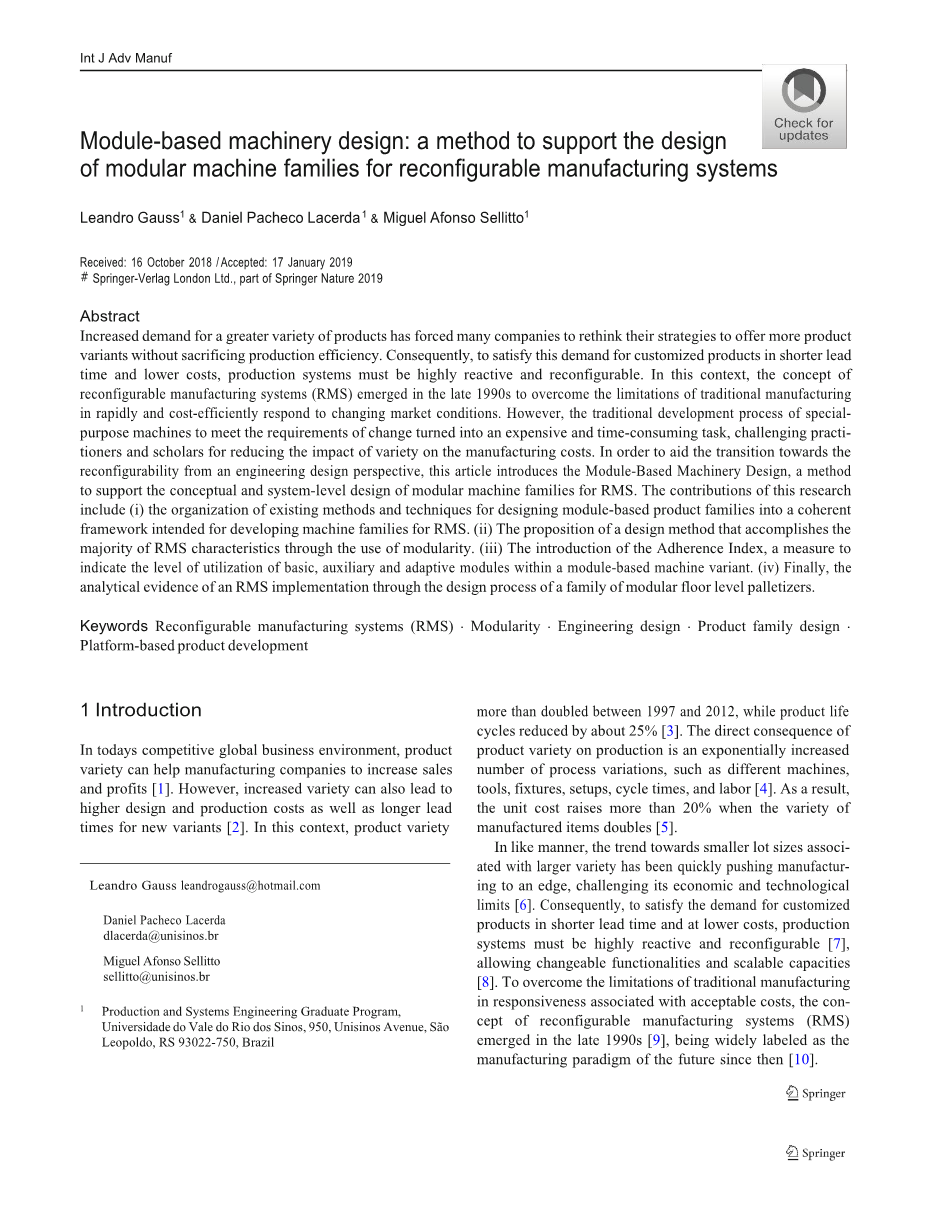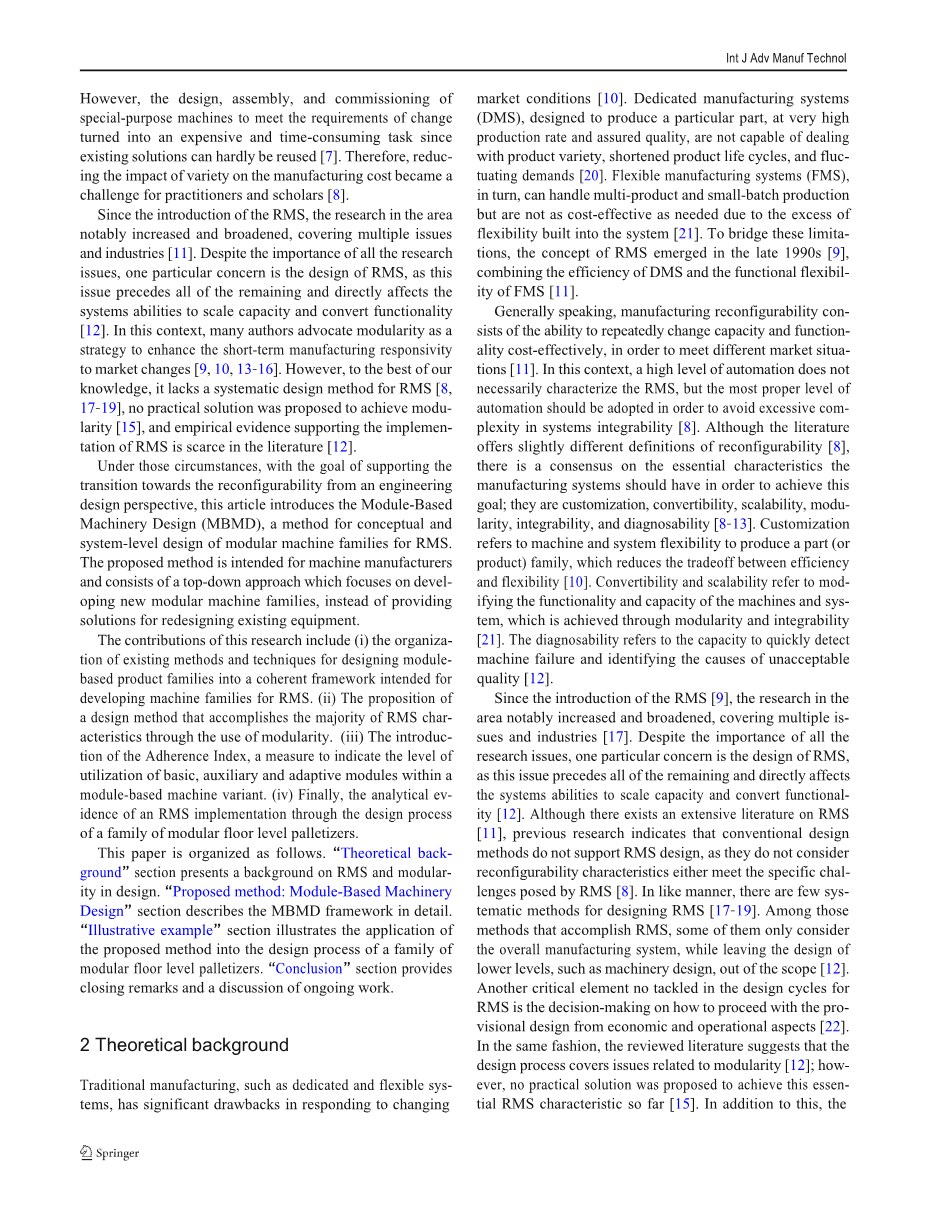英语原文共 26 页,剩余内容已隐藏,支付完成后下载完整资料
Module-based machinery design: a method to support the design of modular machine families for reconfigurable manufacturing systems
Leandro Gauss1 amp; Daniel Pacheco Lacerda 1 amp; Miguel Afonso Sellitto1
Received: 16 October 2018 / Accepted: 17 January 2019
# Springer-Verlag London Ltd., part of Springer Nature 2019
Abstract
Increased demand for a greater variety of products has forced many companies to rethink their strategies to offer more product variants without sacrificing production efficiency. Consequently, to satisfy this demand for customized products in shorter lead time and lower costs, production systems must be highly reactive and reconfigurable. In this context, the concept of reconfigurable manufacturing systems (RMS) emerged in the late 1990s to overcome the limitations of traditional manufacturing in rapidly and cost-efficiently respond to changing market conditions. However, the traditional development process of special- purpose machines to meet the requirements of change turned into an expensive and time-consuming task, challenging practi- tioners and scholars for reducing the impact of variety on the manufacturing costs. In order to aid the transition towards the reconfigurability from an engineering design perspective, this article introduces the Module-Based Machinery Design, a method to support the conceptual and system-level design of modular machine families for RMS. The contributions of this research include (i) the organization of existing methods and techniques for designing module-based product families into a coherent framework intended for developing machine families for RMS. (ii) The proposition of a design method that accomplishes the majority of RMS characteristics through the use of modularity. (iii) The introduction of the Adherence Index, a measure to indicate the level of utilization of basic, auxiliary and adaptive modules within a module-based machine variant. (iv) Finally, the analytical evidence of an RMS implementation through the design process of a family of modular floor level palletizers.
Keywords Reconfigurable manufacturing systems (RMS) . Modularity . Engineering design . Product family design . Platform-based product development
Introduction
In todays competitive global business environment, product variety can help manufacturing companies to increase sales and profits [1]. However, increased variety can also lead to higher design and production costs as well as longer lead times for new variants [2]. In this context, product variety
Leandro Gauss leandrogauss@hotmail.com
Daniel Pacheco Lacerda dlacerda@unisinos.br
Miguel Afonso Sellitto sellitto@unisinos.br
1 Production and Systems Engineering Graduate Program, Universidade do Vale do Rio dos Sinos, 950, Unisinos Avenue, Satilde;o Leopoldo, RS 93022-750, Brazil
more than doubled between 1997 and 2012, while product life cycles reduced by about 25% [3]. The direct consequence of product variety on production is an exponentially increased number of process variations, such as different machines, tools, fixtures, setups, cycle times, and labor [4]. As a result, the unit cost raises more than 20% when the variety of manufactured items doubles [5].
In like manner, the trend towards smaller lot sizes associ- ated with larger variety has been quickly pushing manufactur- ing to an edge, challenging its economic and technological limits [6]. Consequently, to satisfy the demand for customized products in shorter lead time and at lower costs, production systems must be highly reactive and reconfigurable [7], allowing changeable functionalities and scalable capacities [8]. To overcome the limitations of traditional manufacturing in responsiveness associated with acceptable costs, the con- cept of reconfigurable manufacturing systems (RMS) emerged in the late 1990s [9], being widely labeled as the manufacturing paradigm of the future since then [10].
However, the design, assembly, and commissioning of special-purpose machines to meet the requirements of change turned into an expensive and time-consuming task since existing solutions can hardly be reused [7]. Therefore, reduc- ing the impact of variety on the manufacturing cost became a challenge for practitioners and scholars [8].
Since the introduction of the RMS, the research in the area notably increased and broadened, covering multiple issues and industries [11]. Despite the importance of all the research issues, one particular concern is the design of RMS, as this issue precedes all of the remaining and directly affects the systems abilities to scale capacity and convert functionality [12]. In this context, many authors advocate modularity as a strategy to enhance the short-term manufacturing responsivity to market changes [9, 10, 13–16]. However, to the best of our knowledge, it lacks a systematic design method for RMS [8, 17–19], no practical solution was proposed to achieve modu- larity [15], and empirical evidence supporting the implemen- tation of RMS is scarce in the literature [12].
Under those circumstances, with the goal of supporting the
剩余内容已隐藏,支付完成后下载完整资料
资料编号:[603716],资料为PDF文档或Word文档,PDF文档可免费转换为Word
课题毕业论文、外文翻译、任务书、文献综述、开题报告、程序设计、图纸设计等资料可联系客服协助查找。




